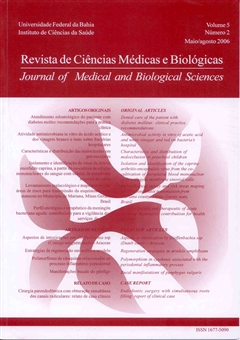Antimicrobial activity in vitro of acetic acid and white vinegar and red on bacteria’s hospital
DOI:
https://doi.org/10.9771/cmbio.v5i2.4117Keywords:
Acetic acid- Microbial sensitivity tests-Pseudomonas aeruginosa-Staphylococcus aureus-Escherichia coli, Vinegar- Microbial sensitivity tests- Pseudomonas aeruginosa-Staphylococcus aureus-Escherichia coliAbstract
Acetic acid and vinegar have a long history and human applicability including the clinical treatment of wounds. Objective: to evaluate in vitro the acid antimicrobial activity of acetic and the vinegar by means of the technique of diffusion of well of Staphylococcus aureus, Pseudomonas aeruginosa and Escherichia coli. The study was applied to assessment of the antimicrobial activity of acetic acid (Merck) a 1,0 e 0,7% and white vinegar and red at 30,0; 25,0 e 10,0%. The strains of Pseudomonas aeruginosa, E. coli e Staphylococcus aureus have been isolated of hospitalized patients. For analysis statistics the test of variance ANOVA - ONEWAY followed of the test of multiple comparisons was used; with level of significance = 5%. In general the white and red vinegars 30.0% and of acetic acid 1,0 and 0.7% had shown significant to antimicrobial activity on Pseudomonas aeruginosa and Escherichia coli. In the concentration of 25,0 and 10.0% there was tenuous growth of some and no action on Staphylococcus aureus. It is possible to consider that there is direct relation of the chemical agent concentration with the antimicrobial activity or inhibition of bacteria.Downloads
Download data is not yet available.
Downloads
Published
2006-01-19
How to Cite
Utyama, I. K. A., Andrade, D. de, Watanabe, E., & Ito, I. Y. (2006). Antimicrobial activity in vitro of acetic acid and white vinegar and red on bacteria’s hospital. Journal of Medical and Biological Sciences, 5(2), 111–116. https://doi.org/10.9771/cmbio.v5i2.4117
Issue
Section
ORIGINAL ARTICLES
License
The Journal of Medical and Biological Sciences reserves all copyrights of published works, including translations, allowing, however, their subsequent reproduction as transcription, with proper citation of source, through the Creative Commons license. The periodical has free and free access.


